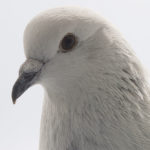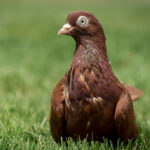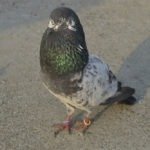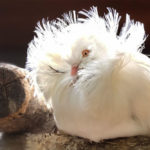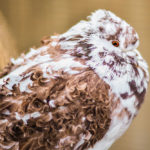The Seraphim Pigeon is a rare breed of show pigeon that is admired for its beauty and poise.
It took many years of painstaking husbandry and breeding to produce the white feathers and distinctive frills of this angelic bird.
Read on for all you need to know about its origins, its physical features, its care needs and behaviors.
How The Seraphim Pigeon Came To Be
To understand how Seraphim Pigeons came to be, you must first understand the elite world of pigeon fancying.
A fancy pigeon is any species of domesticated pigeon that has been bred from the original rock dove species.
There are now over 800 different breeds of fancy pigeon around the world.
There are no other domesticated animals on the planet which have been as successfully bred into as many different varieties as fancy pigeons.
Even Charles Darwin himself was well known to have kept a pigeon coop and experimented with breeding during his research for his seminal work, The Origin of Species.
Fancy pigeons are selectively paired in order to draw out certain characteristics such as size, shape, color or behavior.
If breeding is successful, a new breed can become established and can be entered into shows and competitions all around the world, where the pedigree and quality of the pigeon are judged.
Pigeon fanciers spend years observing their birds and partnering them very carefully in order to produce the most refined offspring, with the hope of achieving perfect show standards for each breed.
And one such dedicated fancier was Ann Ellis.
Ann (Anya) Ellis was looking after her loft of pigeons in East Millone, Illinois, USA, when she began to notice some interesting characteristics emerging amongst her flock of Classic Oriental Frill pigeons.
Some of the younger birds were white as opposed to having the traditional red feathers associated with this breed.
She studied the traits closely over the next few years and began to specifically pair the birds in order to achieve the result she was looking for.
Eventually, Ann managed to breed a pigeon that had the beauty of the Classic Oriental Frill but was as white as a release dove!
She was so amazed when she first beheld this new bird, she exclaimed ‘angel!’ which is where the Seraphim first got its name.
Ann went on to refine the physical characteristics of her birds until they became the beautiful breed they are today.
They were first recognised as a breed in the USA in 1995, and in Europe in 1997, and there are now Seraphim Pigeon competitions and associations all over the world.
Ann Ellis laid out her last set of show standards in 2017.
The Physical Appearance Of The Seraphim Pigeon
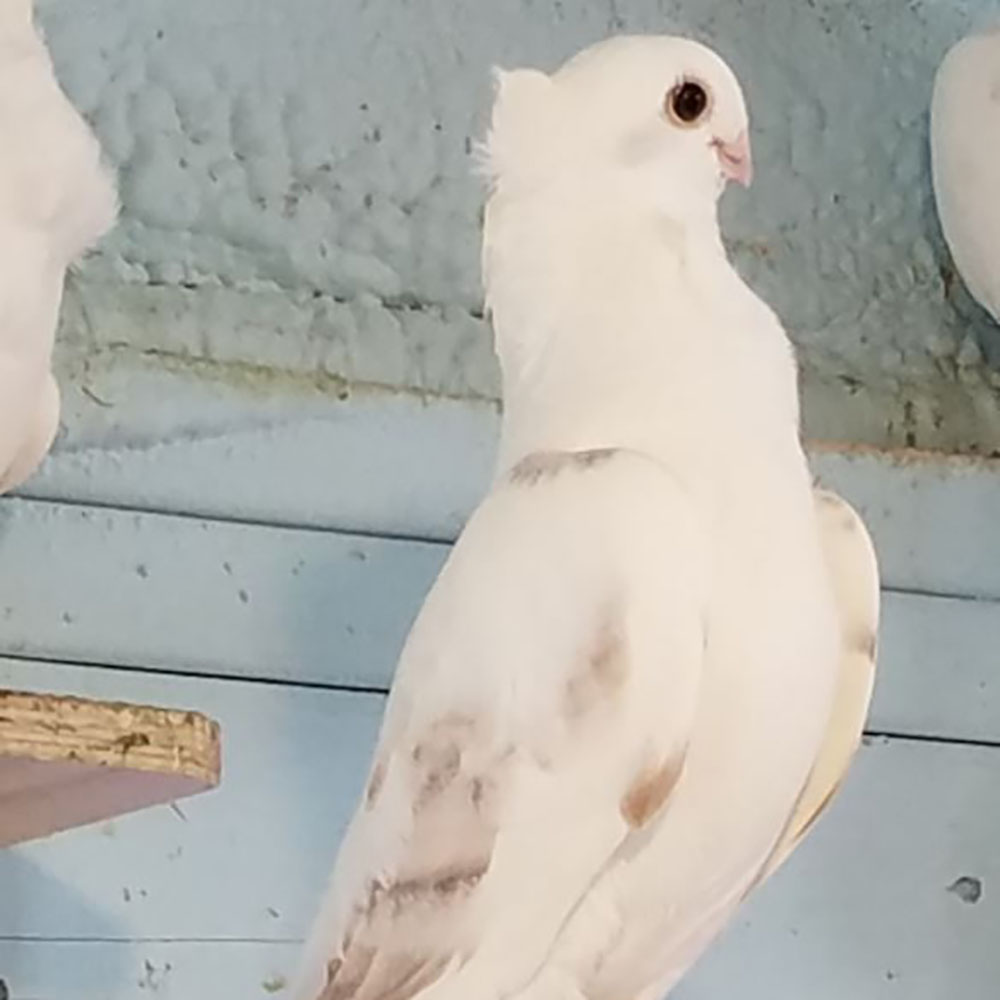
White Feathers
Seraphim pigeons have many notable and stunning physical traits, and perhaps the most obvious of all are their pure white feathers.
Seraphim are not born white, but actually have red or yellow feathers as juveniles, which become white on the second moulting.
This is due to a specific genetic mutation and is not considered a fault in judging terms.
Rounded Head
Seraphim should have beautifully rounded heads with an elegant needlepoint peak that sits just below the top of the skull at the back of the head.
There should be a smooth swoop from the top of the skull to the tip of the peak which creates a quiff-life shape. The bird should have a visible gullet.
Beak
The beak should be small and very light pink in color. It should protrude a little way from the front of the head and should be down set with only a very small, pale cere.
A Seraphim beak should be strong, and big enough to feed its young.
Chest
Seraphim pigeons have proud chests with prominent chest fills which are thick and heavily ruffled.
Mane
An uninterrupted mane should flow from the tip of the peak to the bird’s shoulders and should stand out from the bird’s back.
The two sides of the mane should meet in a point on the bird’s back and should be symmetrical.
Tail
Seraphim should have a long tail that almost touches the ground. It should have 12 feathers and should not be too narrow.
Eyes
The eyes should be dark bull black with no pale rings around the edges.
Feet
Seraphim feet should be covered in white feathers that splay in a star-shape over each toe.
Wings
Seraphim wings should be neat and smooth and well delineated from the rest of the body.
Size
Seraphim are compact, neat and smooth birds. The females are slightly more petite than the males.
Stance
The stance of these birds is considered highly important during judging because it is what gives them their ethereal quality.
Seraphim pigeons should hold their heads high and stand with their chests protruding forwards and upwards proudly.
Their tails should ride low and almost touch the ground. The overall impression of this stance is of a bird about to take flight, and it is what makes them appear angelic and regal.
The Habitat Of The Seraphim Pigeon
Seraphim Pigeons are a domestic breed and they therefore do not exist in the wild. Their geographic range depends entirely on the location of their breeders and they do not have a natural habitat.
The Status Of The Seraphim Pigeon
Seraphim Pigeons are classified in the rare breeds group among fancy pigeons.
However, their status as a ‘rare’ breed does not indicate that they are endangered or near extinction, it simply indicates that they have been domestically bred and there are not many of them about.
They are very difficult to breed and not many fanciers keep them, which is why they are considered rare.
The Diet Of The Seraphim Pigeon
Seraphim largely eat a mixture of seeds with a good balance of nutrients and vitamins.
They enjoy having a variety of different seed mixes so that they don’t become bored of one type. They also like eating peas more than most other pigeon breeds do.
Seeds that Seraphims enjoy include:
- Rapeseed
- Sunflower seeds
- Millet
- Wheat
- Safflower
- Milo
The Flight Of The Seraphim Pigeon
Due to the fact that these bids are closely related to the Classic Oriental Frill, they are incredibly good fliers.
Those the red plumage was bred out of them, the Oriental Frill’s agility and speed in the air has thankfully remained.
Seraphim pigeons are a delight to watch. They have the ability to twist and turn sharply in the air and can even perform backflips when they are really stretching their wings.
They love to fly and require a coop that has plenty of room to allow them to do so. Seraphim that don’t have space to spread their wings can become despondent and unwell.
The Character Of The Seraphim Pigeon
The downside to the Seraphim having such excellent agility in the air is that they are a particularly nervous breed.
Compared to many other domestic pigeons, Seraphim do not take well to being handled and often make a quick escape when humans come too close.
They prefer to perch high up where they don’t feel as vulnerable or exposed, and they are not good at being petted or stroked.
They are also not very good at homing, which means that you cannot let Seraphim pigeons fly in the open because they will most likely fly away and not be able to find their way home again.
In order to maintain a healthy owner / pet relationship, constant handling from an early age is required. These birds can become very jittery and nervous otherwise and won’t do well during judging.
In terms of how they react to other birds, Seraphim pigeons can be rather testy coop mates.
They often become agitated and aggressive towards one another if they feel that another bird is becoming too imposing and dominant.
They are territorial, and do not like their personal space to be encroached upon by another. If this happens they will become quarrelsome and feisty.
These pigeons are small, agile and very smart. They are excellent problem solvers and are quick to adapt to new situations.
Another handy trait is that they are not loud birds, in fact, their cooing is soft and rather melodious compared to many other pigeon breeds.
Mating And Breeding Amongst Seraphim Pigeons
It took Ann Ellis many years to breed these pigeons to the perfect standard, and as a result they are a difficult breed to maintain.
Parent pigeons must be of excellent quality and health to produce pure white Seraphim offspring with the desired physical traits, and many fanciers have tried and failed to achieve the quality they are after.
What makes matters even harder is that Seraphim pigeons are not very good breeders in general.
They have to be coaxed and encouraged to mate, and partners often have to be put together for sometime before they are successful.
They are physically able to mate from the age of 6 months, and when sexually mature the male birds will make a loud cooing noise and perform a mating dance to entice the female.
If two Seraphim do successfully mate, they can produce up to 16 hatchlings a year, and both parents are very attentive to their young even after fledglings have launched.
Creating A Home For Seraphim Pigeons
If you are lucky enough to get your hands on one of these rare and beautiful birds, or indeed manage to breed them, you will need to keep them in a large and high ceiling loft or coop which has plenty of space for them to fly about.
As Seraphim are so bad at homing, you will not be able to let them fly freely in the wild, so making their coop as natural and airy as possible is key.
These pigeons love natural sunlight, and high perches. They do not sit well on small perches due to the setting of their feet, so large perches will be much better.
They walk well and therefore you should put plenty of grain, hay, cop pellets or straw. This will not only protect their feet but will also help to keep their plumage clean when they poop.
As Seraphim love bathing in water, be sure to provide a bird bath so that they can stay refreshed and clean.
Final Thoughts
Seraphim Pigeons are a truly designer pet! Not only are they stylish and strikingly beautiful but they are also incredibly rare.
Although tricky to breed and maintain, if you have the time, expertise and dedication, these birds make amazing pets and will bring endless joy to any fancier’s coop.

